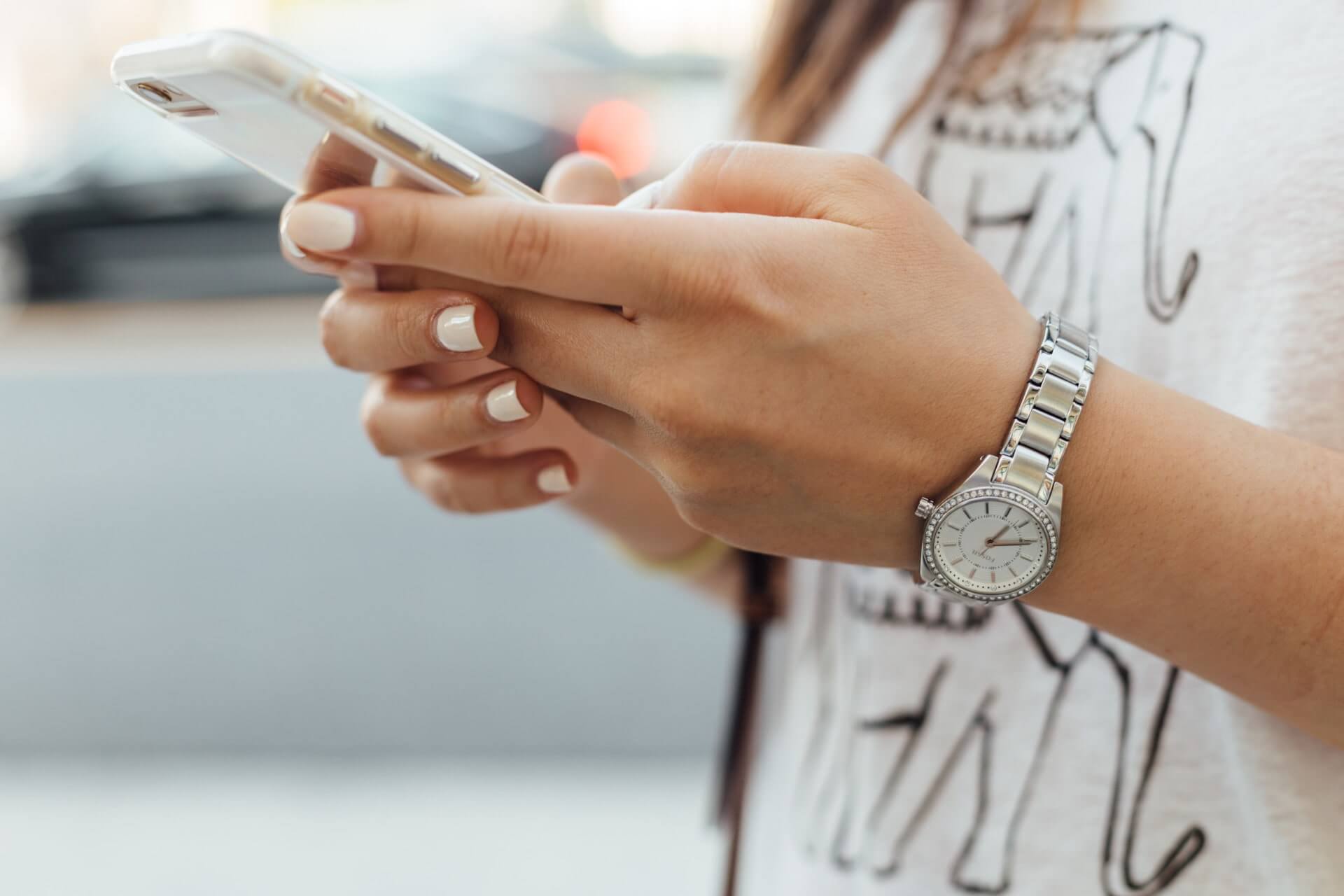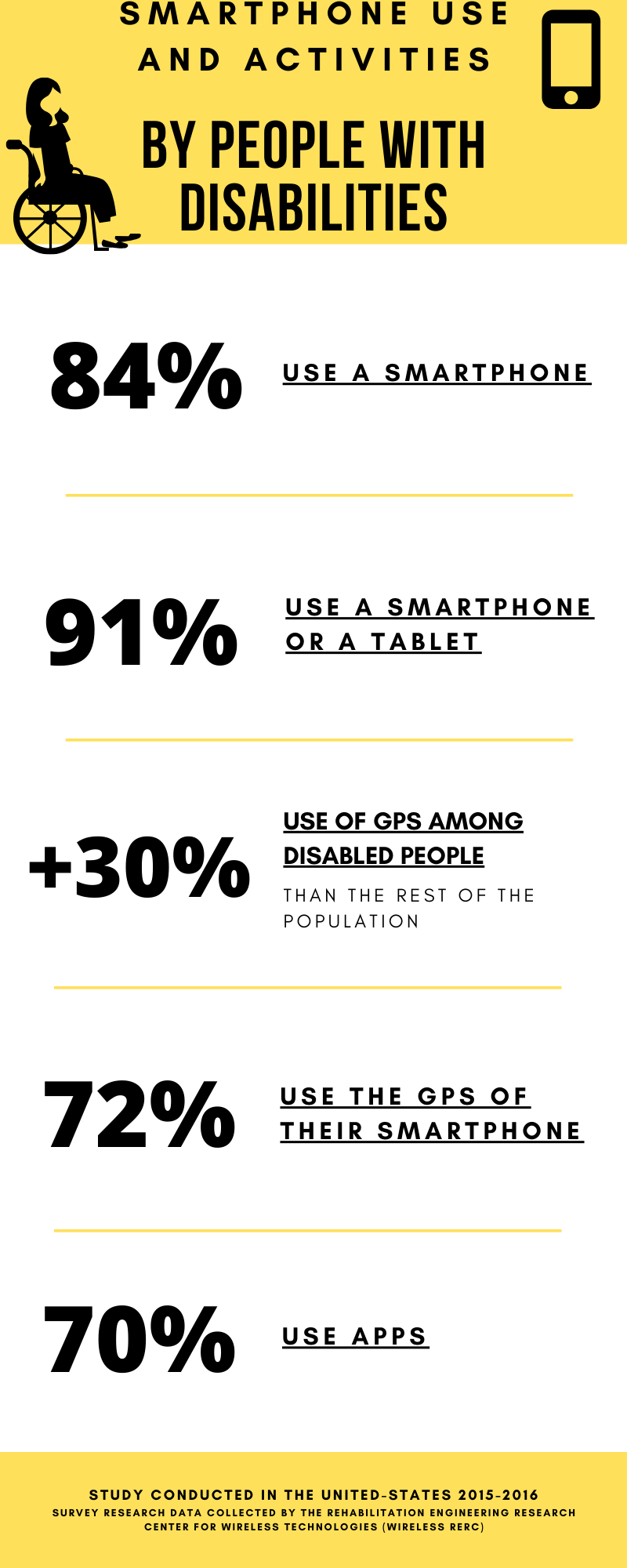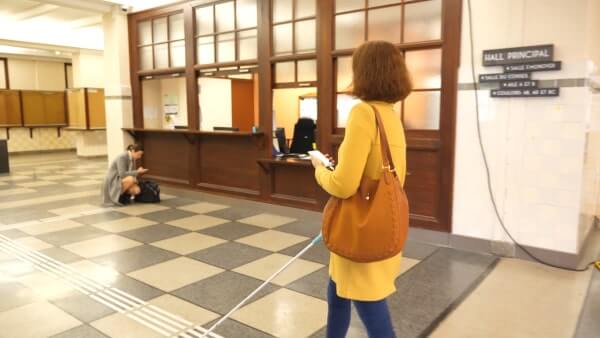
« Les personnes handicapées n’utilisent pas de smartphones. »
Aujourd’hui, les smartphones offrent des solutions d’assistance fiables et économiques aux personnes handicapées. Applications, GPS, paramètres d’accessibilité… la plupart de ces fonctionnalités sont devenues essentielles pour surmonter les obstacles du quotidien, mais aussi pour profiter de ces trésors technologiques au même titre que le reste de la population.
On croit souvent à tort que les personnes handicapées ne peuvent pas utiliser de smartphone. Pourtant, qu’elles souffrent de handicaps sensoriels, cognitifs ou moteurs, elles ont bel et bien accès aux technologies mobiles, avec toutefois quelques variantes pour certaines activités.
Regardez par vous-même !

L’étude a été menée entre 2015 et 2016 par le Centre de recherche en ingénierie de réadaptation pour les technologies sans fil Shepherd Center.
Au total, 7 500 personnes présentant une typologie de handicap ont répondu à l’enquête, qui se répartit comme suit :
Difficulté à marcher, à se tenir debout ou à monter les escaliers : 42 %
Malentendants : 31 %
Sourds : 12 %
Malvoyants : 13 %
Aveugle : 6 %
Difficulté à utiliser les mains ou les doigts 25 %
Difficulté à se concentrer, à prendre des décisions ou à se souvenir : 21 %
Inquiétude, nervosité ou anxiété fréquentes : 23 %
Difficulté à utiliser les bras : 20 %
Difficulté à parler : 17 %
5 chiffres clés :
⊗ 84 % des répondants déclarent utiliser un smartphone au quotidien
⊗ Atteignant 91 % en incluant l’utilisation des tablettes
⊗ Les personnes handicapées utilisent le GPS de leur smartphone 30 % de plus que le reste de la population
⊗ Ce qui représente 72%
⊗ 70 % d’entre eux utilisent des applications.
L’étude a été réalisée entre 2015 et 2016 aux États-Unis par le Rehabilitation Engineering Research Center for Wireless Technologies Shepherd Center : lire l’enquête complète .
Informations complémentaires :
Vous vous demandez comment les personnes malvoyantes utilisent un smartphone ? Cette question revient souvent, et c’est normal !
Le smartphone devrait être synonyme d’inaccessibilité pour les personnes aveugles et malvoyantes. Pourtant, il est devenu un compagnon indispensable pour beaucoup d’entre elles.
Découvrez comment : Le smartphone, une révolution pour les aveugles et malvoyants !
media

91% of people with disabilities use a smartphone or a tablet on a daily basis.
writer

Zoe Gervais
Content Manager
stay updated
Get the latest news about accessibility and the Smart City.
other articles for you

Open Data Is Key to Fostering Universal Accessibility
Open data represents an opportunity for cities to reach universal accessibility. It shows the missing links of the mobility chain.
Our Audio Beacons Guide the Blind and Visually Impaired at the Helsinki Subway
The Helsinky subway improved their audio signage system by installing on demand and remotely activated audio beacons.
7 Good Reasons to Install Audio Beacons at Your Public Transport Network
Audio beacons are an efficient way to provide more autonomy to blind and visually impaired people. They can easily use public transport.

Will Remote Activation Become the Norm for Accessible Pedestrian Signals?
More and more cities like New York have been exploring remote activation to trigger accessible pedestrian signals.
share our article!
more articles

Disability Statistics in the US: Looking Beyond Figures for an Accessible and Inclusive Society
Disability Statistics in the US: Looking Beyond Figures for an Accessible and Inclusive Society Around 61 million adults in the United States live with a disability. Diving into disability statistics in the US will help us know exactly who is concerned and what...
Our Audio Beacons Guide the Blind and Visually Impaired at the Helsinki Subway
Our Audio Beacons Guide the Blind and Visually Impaired at the Helsinki SubwayOur audio beacons equip the new line of the Helsinki subway in Finland. They help blind and visually impaired people locate the points of interest of a station. For users with visual...

Will Remote Activation Become the Norm for Accessible Pedestrian Signals?
Will Remote Activation Become the Norm for Accessible Pedestrian Signals?Without pushbutton, there are no accessible pedestrian signals. That’s how APS work in the U.S. But more and more cities have been exploring remote activation like New York City. The Department...

Hearing Impaired People: a Multitude of Profiles for Different Needs
Hearing Impaired People: a Multitude of Profiles for Different Needs Did you know that hearing impaired people have several profiles and that the way they identify themselves is important? You may be familiar with deaf and hard of hearing people but for each of...
NEVER miss the latest news about the Smart City.
Sign up now for our newsletter.
Unsubscribe in one click. The information collected is confidential and kept safe.
powered by okeenea
The French leading company
on the accessibility market.
For more than 25 years, we have been developing architectural access solutions for buildings and streets. Everyday, we rethink today’s cities to transform them in smart cities accessible to everyone.
By creating solutions ever more tailored to the needs of people with disabilities, we push the limits, constantly improve the urban life and make the cities more enjoyable for the growing majority.


